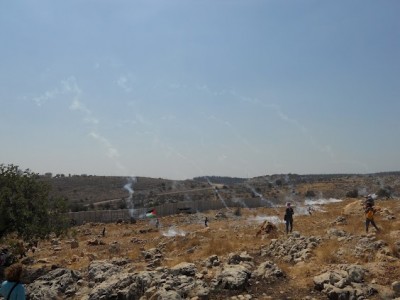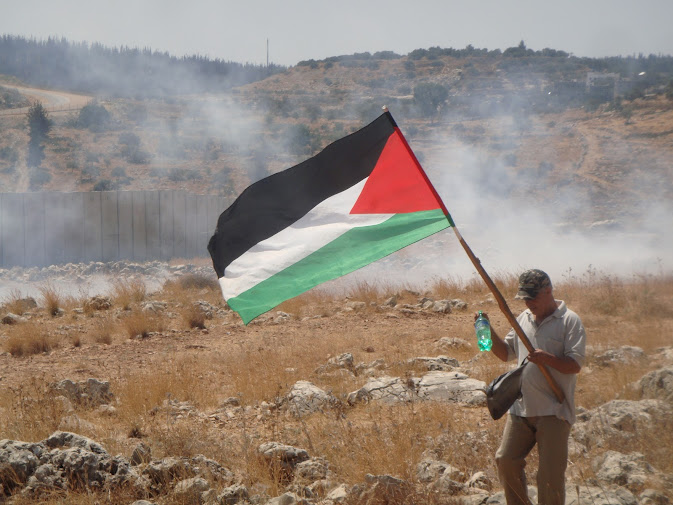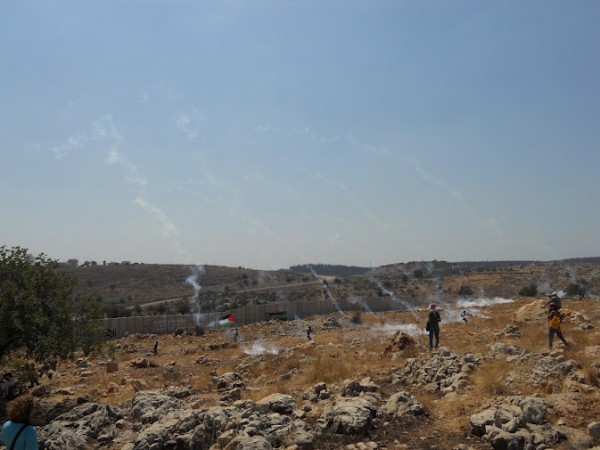By Steve Plaank
2 July 2012 | International Solidarity Movement, West Bank
On Friday, June 29th, dozens of residents of the Palestinian village, Ni’lin demonstrated in opposition to the ongoing apartheid carried out by the Israeli Occupation Forces (IOF). The village of Ni’lin is located near the 1967 Green Line and has been a center of popular resistance throughout the history of the Israel occupation of Palestine.
Following the Friday prayers, Palestinians, along with approximately a dozen internationals, marched to the recently completed apartheid wall. There they were met with a heavy dousing of a foul-smelling liquid fired out of a truck mounted water canon commonly referred to as the ‘skunk truck’.
In true Ni’lin spirit, the protestors were not deterred and continued expressing their steadfast opposition. Following the skunk truck, the IOF shot close to 100 tear gas canisters into the hills and fired upon protestors with rubber-coated steel bullets from the safety of their perch on a ridge and from the security of their armored jeeps.
Despite the use of such weapons, no protestors needed to be taken to the hospital although many were treated, sometimes multiple times, for tear gas inhalation.
After the demonstration had come to an end, the international visitors were treated to an educational presentation in the newly reopened Center for the Ni’lin Popular Resistance.
Ni’lin resident Saeed Amireh explained the history of both the apartheid and the popular resistance in Ni’lin. More information can be found here.
Saeed himself has grown up with the aggressions of an apartheid state on a daily basis. Life has been difficult during the 22 years of his existence. In the last 10 years alone, the village has experienced a reign of terror and oppression. As the nearby illegal settlements grew in size, they began occupying the agricultural lands upon which the residents of Ni’lin depend for their livelihood. Since 1967, the village’s lands have decreased from the 58,000 dunums to only 7,000 remaining dunums. Five Israeli colonies have been built around Ni’lin. With the settlers came increased oppression and violence from the IOF.
When the order came to build the apartheid wall in between the illegal Israeli settlements and the long standing village of Ni’lin, the resistance from the Palestinians took on a new life. Through unending protests and refusals to cooperate, they were able to force the Israelis to change the location of the wall, saving 1500 dunums from confiscation.
Despite the adjustment, the route of the wall still annexes a great deal of Ni’lin’s agricultural land. The residents continue to demonstrate against this apartheid structure. Saeed captured the sentiment of
the village saying that, “everybody deserves freedom and peace.”
The struggle for peace, however, has been faced with a violent response from the IOF. As Saeed stated, “there is no freedom without a price.”
Since beginning the popular protests in 2007, Ni’lin has suffered over 350 arrests, 5 deaths, multiple injuries from the use of live ammunition, and at least 15 people with bones broken from the firing of tear gas.
Saeed embodies the resistance spirit of Ni’lin. He has no memories of life without occupation. He dreams of being able to visit the sea, which he can glimpse from his rooftop on a clear day, but like other Palestinians in the West Bank, is unable to access without a difficult to receive permission.
“Daily life is a resistance,” Saeed says. The fact that Ni’lin continues to exist despite the efforts to make life unbearable, is a resistance to the ongoing apartheid. Israel has not only cut the village from much of its agricultural lands but also from their water resources. Thus, Ni’lin has been cut from its main sources of income.
“The occupation is not only shooting the people…the occupation in our lives is like a cancer in the body. [It affects] everything in our life,” says Saeed.
Saeed wants visibility and international attention for his village. “I want people to see our existence… people have no work, no jobs, no land. By coming here people can stand [by us] and see [what is happening].”
As for the the Palestinians of Ni’lin, their struggle is far from over. They are fighting for survival. As Saeed puts it, “we will not stop the fight, even though we are tired, we will not stop the fight.”
Steve Plaank is a volunteer with the International Solidarity Movement (name has been changed).





